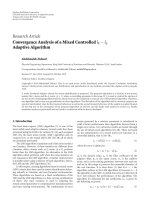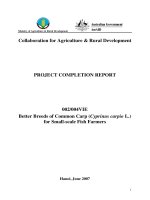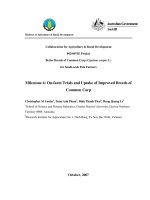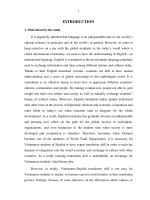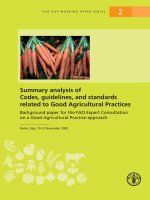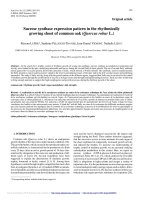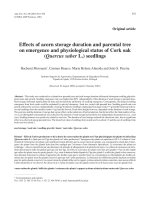Morpho physiological analysis of adaptive responses of common bean (phaseolus vulgaris l ) to drought stress
Bạn đang xem bản rút gọn của tài liệu. Xem và tải ngay bản đầy đủ của tài liệu tại đây (1.22 MB, 101 trang )
Departament de Biologia Animal, Biologia Vegetal i Ecologia
Unitat Fisiologia Vegetal
Morpho-physiological analysis of adaptive
responses of common bean (Phaseolus vulgaris L.)
to drought stress
Doctoral Thesis
Doctoral Program of Plant Biology and Biotechnology
JOSÉ A. POLANÍA PERDOMO
September, 2016
Morpho-physiological analysis of adaptive responses of common
bean (Phaseolus vulgaris L.) to drought stress
Dissertation presented in fulfilment of the requirements for the degree of Doctor in
Plant Biology and Biotechnology by
JOSÉ A. POLANÍA PERDOMO
Supervised by
Dr. Charlotte Poschenrieder, Dep. Biología Animal, Biol. Vegetal y Ecología (UAB)
Dr. Idupulapati M. Rao and Dr. Stephen E. Beebe
Bean Program
International Center for Tropical Agriculture (CIAT)
José A. Polania Perdomo
Charlotte Poschenrieder
Idupulapati M. Rao
September 2016
Stephen E. Beebe
Table of Contents
Abstract .................................................................................................................... 10
Resumen .................................................................................................................. 12
Introduction ............................................................................................................. 15
Hypothesis ............................................................................................................... 17
Objectives ................................................................................................................ 18
Thesis outline .......................................................................................................... 19
References ................................................................................................................ 20
Chapter 1. Identification of shoot traits related with resistance to terminal
drought stress in common beans .......................................................................... 21
1.1
Introduction .......................................................................................... 22
1.2
Materials and methods ........................................................................ 26
1.2.1
Experimental site and meteorological conditions ................................... 26
1.2.2
Plant material ......................................................................................... 27
1.2.3
Experimental design .............................................................................. 28
1.2.4
Yield measurements and phenological assessment .............................. 29
1.2.5
Shoot traits measurements .................................................................... 29
1.2.6
Statistical analysis.................................................................................. 31
1.3
Results .................................................................................................. 32
1.3.1
Grain yield.............................................................................................. 32
1.3.2
Phenological assessment: days to flowering (DF) and days to
physiological maturity (DPM) ................................................................. 33
1.3.3
Leaf stomatal conductance, SCMR and carbon isotope discrimination . 36
1.3.4
Canopy biomass, partitioning indices and yield components ................. 37
1.4
Discussion ............................................................................................ 42
1.4.1
Grain yield and phenology ..................................................................... 42
1.4.2
SPAD chlorophyll meter readings, stomatal conductance and CID ....... 43
1.4.3
Canopy biomass, photosynthate remobilization and sink strength ........ 46
Conclusions ......................................................................................................... 48
References ............................................................................................................ 49
4
Chapter 2. Estimation of phenotypic variability in symbiotic nitrogen fixation
(SNF) ability of common bean under drought stress using 15N natural abundance
in grain tissue .......................................................................................................... 53
2.1
Introduction .......................................................................................... 54
2.2
Materials and methods ........................................................................ 57
2.2.1
Experimental site and meteorological conditions ................................... 57
2.2.2
Plant material ......................................................................................... 57
2.2.3
Experimental design .............................................................................. 57
2.2.4
Determination of symbiotic nitrogen fixation ability using shoot and grain
58
2.2.5
Physiological measurements ................................................................. 59
2.2.6
Statistical analysis.................................................................................. 59
2.3
Results .................................................................................................. 60
2.3.1
Estimation of Ndfa and differences in 15N natural abundance in shoot and
grain ....................................................................................................... 60
2.3.2
Differences in SNF ability and genotypic response to drought ............... 63
2.4
Discussion ............................................................................................ 68
2.4.1
Estimation of Ndfa and differences in 15N natural abundance in shoot and
grain ....................................................................................................... 68
2.4.2
Differences in SNF ability and genotypic response to drought ............... 69
Conclusions ......................................................................................................... 72
References ............................................................................................................ 73
Chapter 3. Identification of root traits related with drought resistance in common
bean .......................................................................................................................... 76
3.1
Introduction .......................................................................................... 77
3.2
Materials and methods........................................................................... 80
3.2.1
Plant material ......................................................................................... 80
3.2.2
Experimental conditions ......................................................................... 80
3.2.3
Experimental design .............................................................................. 80
3.2.4
Physiological measurements ................................................................. 81
3.2.5
Statistical analysis.................................................................................. 82
3.3
Results .................................................................................................. 83
3.4
Discussion ............................................................................................ 90
5
Conclusions ......................................................................................................... 95
References ............................................................................................................ 95
General Conclusions .............................................................................................. 99
List of Figures
Figure 1. Phenotypic evaluation of 36 bean lines at CIAT Palmira, Colombia in 2013,
under irrigated conditions (A) and drought stress conditions (B). .............................. 26
Figure 2. Rainfall distribution, pan evaporation, maximum and minimum temperatures
during crop growing period at Palmira, Colombia in 2012 and 2013. ........................ 32
Figure 3. Identification of genotypes that are adapted to drought conditions and are
responsive to irrigation on a Mollisol at Palmira. Genotypes that yielded superior with
drought and were also responsive to irrigation were identified in the upper, right hand
quadrant .................................................................................................................... 33
Figure 4. Identification of genotypes with greater values of grain yield and grain carbon
isotope discrimination (CID) under drought conditions on a Mollisol at Palmira. Higher
yielding genotypes with greater values of CID were identified in the upper, right hand
quadrant. ................................................................................................................... 37
Figure 5. Identification of genotypes with greater values of grain yield and canopy
biomass under drought conditions on a Mollisol at Palmira. Higher yielding genotypes
with greater values of canopy biomass were identified in the upper, right hand quadrant
.................................................................................................................................. 38
Figure 6. Identification of genotypes with greater values of grain yield and pod
partitioning index (PPI) under drought conditions on a Mollisol at Palmira. Higher
yielding genotypes with greater values of PPI were identified in the upper, right hand
quadrant .................................................................................................................... 39
Figure 7. Identification of genotypes with greater values of grain yield and pod harvest
index (PHI) under drought conditions on a Mollisol at Palmira. Higher yielding
genotypes with greater values of PHI were identified in the upper, right hand quadrant.
.................................................................................................................................. 40
Figure 8. Identification of genotypes with greater values of grain yield and seed number
per area under drought conditions on a Mollisol at Palmira. Higher yielding genotypes
with greater values of SNA were identified in the upper, right hand quadrant. .......... 41
Figure 9. Identification of genotypes that combine greater total nitrogen derived from
the atmosphere in kg ha-1 estimated using grain tissue (TNdfa-G) with superior grain
yield under irrigated and drought conditions when grown in a Mollisol at CIAT-Palmira,
Colombia. Higher TNdfa-G genotypes with greater grain yield were identified in the
upper, right hand quadrant. Genotypes identified with symbols of (■) are commercial
varieties and with a symbol of (▲) is P. acutifolius .................................................... 64
7
Figure 10. Identification of genotypes that combine greater total nitrogen derived from
the soil in kg ha-1 estimated using grain tissue (TNdfs-G) with superior grain yield under
irrigated and drought conditions when grown in a Mollisol at CIAT-Palmira, Colombia.
Higher TNdfs-G genotypes with greater grain yield were identified in the upper, right
hand quadrant. Genotypes identified with symbols of (■) are commercial varieties and
with a symbol of (▲) is P. acutifolius ......................................................................... 64
Figure 11. Identification of genotypes that combine greater total nitrogen derived from
the atmosphere in kg ha-1 estimated using shoot tissue (TNdfa-SH) with superior grain
yield under irrigated and drought conditions when grown in a Mollisol at CIAT-Palmira,
Colombia. Higher TNdfa-SH genotypes with greater grain yield were identified in the
upper, right hand quadrant. Genotypes identified with symbols of (■) are commercial
varieties and with a symbol of (▲) is P. acutifolius .................................................... 65
Figure 12. Identification of genotypes that combine greater values of %nitrogen derived
from the atmosphere using grain tissue (%Ndfa-G) with higher values of nitrogen use
efficiency (NUE) in terms of kg of grain produced kg-1 of shoot N uptake under drought
conditions when grown in a Mollisol at CIAT-Palmira, Colombia. Higher %Ndfa-G
genotypes with greater values of NUE were identified in the upper, right hand quadrant
.................................................................................................................................. 66
Figure 13. Identification of genotypes with greater nitrogen concentration in grain and
grain yield under drought conditions on a Mollisol at Palmira, higher N concentration in
grain genotypes with greater grain yield were identified in the upper, right hand
quadrant. ................................................................................................................... 67
Figure 14. Soil cylinder system used for phenotypic evaluation of 36 bean genotypes
under greenhouse conditions at CIAT Palmira, Colombia (A). Bean line NCB 226 with
its fine root system development under drought stress conditions (B). ..................... 81
Figure. 15 Genotypic differences in visual root growth rate under drought conditions in
Palmira. ..................................................................................................................... 84
Figure 16. Identification of genotypes with greater values of grain yield (field conditions)
and total root length (greenhouse conditions) under drought stress in Palmira. Higher
yielding genotypes with greater values of total root length were identified in the upper,
right hand quadrant. .................................................................................................. 85
Figure 17. Identification of genotypes with greater values of grain yield (field conditions)
and total root biomass (greenhouse conditions) under drought stress in Palmira. Higher
yielding genotypes with greater values of root biomass were identified in the upper,
right hand quadrant. .................................................................................................. 86
Figure 18. Identification of genotypes with greater values of total root length (TRL) and
fine root proportion (FRP) under drought stress in Palmira. Higher TRL genotypes with
greater values of FRP were identified in the upper, right hand quadrant. .................. 87
8
List of Tables
Table 1. Characteristics of common bean genotypes used in the field studies ......... 27
Table 2. Correlation coefficients (r) between final grain yield (kg ha -1) and other shoot
attributes of 36 genotypes of common bean grown under irrigated and drought
conditions in a Mollisol in Palmira.............................................................................. 34
Table 3. Phenotypic differences in leaf stomatal conductance, SPAD chlorophyll meter
reading, days to flowering and days to physiological maturity of 36 genotypes of
common bean grown under irrigated and drought conditions in 2012 and 2013 at
Palmira, Colombia. Values reported are mean for two seasons. ............................... 35
Table 4. Correlation coefficients (r) between % nitrogen derived from the atmosphere
estimated using shoot tissue (%Ndfa-SH), % nitrogen derived from the atmosphere
estimated using grain tissue (%Ndfa-G), total nitrogen derived from the atmosphere in
kg ha-1 using grain tissue (TNdfa-G), total nitrogen derived from the soil in kg ha-1 using
grain tissue (TNdfs-G), nitrogen use efficiency in kg of grain produced kg-1 of N uptake
in the shoot (NUE), canopy biomass in kg ha-1 (CB) and grain yield in kg ha-1 (GY) of
36 bean genotypes of grown under irrigated and drought conditions in a Mollisol at
CIAT-Palmira, Colombia. Values reported are from analysis of data collected from two
seasons of evaluation (2013 and 2014). ................................................................... 61
Table 5. Phenotypic differences in % nitrogen derived from the atmosphere estimated
using shoot tissue (%Ndfa-SH), % nitrogen derived from the atmosphere estimated
using grain tissue (%Ndfa-G), shoot 15N natural abundance and grain 15N natural
abundance of 36 genotypes of common bean grown under irrigated and drought
conditions in 2012 and 2013 at Palmira, Colombia. .................................................. 62
Table 6. Correlation coefficients (r) between visual root growth rate in mm day-1
(VRGR), total root biomass in g plant-1 (TRB), total root length in m plant-1 (TRL), mean
root diameter in mm (MRD), total root volume in cm 3 (TRV), fine root proportion in %
(FRP), canopy biomass in kg ha-1 (CB), grain yield in kg ha-1 (GY) and grain C isotope
discrimination in ‰ (GCID) of 36 bean genotypes grown under drought conditions at
Palmira. ..................................................................................................................... 84
Table 7. Eigen values and percent of total variation and component matrix for the
principal component axes. ......................................................................................... 88
Table 8. Root and shoot traits related to the water saving ideotype and the water
spending ideotype proposed for targeting improved common bean genotypes to
drought prone agroecological zones. ........................................................................ 94
Acknowledgements
Thanks to the Bill and Melinda Gates Foundation (BMGF), United States Agency for
International Development (USAID) and the CGIAR research program on grain
legumes and the International Center for Tropical Agriculture (CIAT) for financial
support of research on improving drought resistance in common bean.
Special thanks to I.M. Rao, S. Beebe and C. Poschenrieder for their leadership in this
work, for shared their knowledge; for their dedication and attention during my academic
training and execution of the thesis.
I also thank Edilfonso Melo, Miguel Grajales, Cesar Cajiao, Mariela Rivera and bean
breeding and physiology teams at CIAT, Colombia for their help.
10
Abstract
Common bean (Phaseolus vulgaris L.) is the most important food legume in the diet of
poor people in the tropics. This legume is cultivated by small farmers and is usually
exposed to unfavorable conditions with minimum use of inputs. Drought and low soil
fertility, especially phosphorus (P) and nitrogen (N) deficiencies, are major limitations
to bean yield in smallholder systems. Beans can derive part of their required N from
the atmosphere through symbiotic nitrogen fixation (SNF). Drought stress severely
limits SNF ability of plants. Identification of traits associated with drought resistance
contributes to improving the process of designing bean genotypes adapted to these
conditions.
Field studies were conducted at the International Center for Tropical Agriculture (CIAT),
Palmira, Colombia to determine the relationship between grain yield and different
parameters in elite lines selected for drought resistance over the past decade. The
selected traits were effective use of water (EUW), canopy biomass, remobilization of
photosynthates to grain (pod partitioning index, harvest index and pod harvest index)
and SNF ability. Moreover, in field trials we also validated the use of
15N
natural
abundance in grain tissue to quantify phenotypic differences in SNF ability for its
implementation in breeding programs aiming to improve SNF in common bean. Carbon
isotope discrimination (CID) was used for estimation of water use efficiency (WUE) and
effective use of water (EUW). A set of 36 bean genotypes belonging to the Middle
American gene pool were evaluated under field conditions with two levels of water
supply (irrigated and rainfed) over two seasons. Additionally, a greenhouse study was
conducted at CIAT using plastic cylinders with soil inserted into PVC pipes, to
determine the relationship between grain yield and different root parameters such as
total root length, fine root production and visual root growth rate in same group of elite
lines under drought stress.
Eight bean lines (NCB 280, NCB 226, SEN 56, SCR 2, SCR 16, SMC 141, RCB 593
and BFS 67) were identified as resistant to drought stress. Resistance to terminal
11
drought stress was positively associated with EUW combined with a deeper and
vigorous root system, better plant growth, and superior mobilization of photosynthates
to pod and seed production, but negatively associated with days to flowering and days
to physiological maturity. Based on phenotypic differences in CID, leaf stomatal
conductance, canopy biomass and grain yield under drought stress, the tested lines
were classified into two groups, water savers and water spenders. These groups also
differ in their root characteristics, water spenders with a vigorous and deeper root
system and water savers genotypes with a moderate to shallow root system and more
presence of fine roots.
We used 15N natural abundance method to compare SNF ability estimated from shoot
tissue sampled at mid-pod filling growth stage vs. grain tissue sampled at harvest. The
results showed a significant positive correlation between nitrogen derived from the
atmosphere (Ndfa), estimated using shoot tissue at mid-pod filling, and Ndfa estimated
using grain tissue at harvest. The method showed phenotypic variability in SNF ability
under both drought and irrigated conditions. A significant reduction in SNF ability was
observed under drought stress. We suggest that the method of estimating Ndfa using
grain tissue (Ndfa-G) can be applied in bean breeding programs to improve SNF ability.
Using this method of Ndfa-G, we identified four bean lines (RCB 593, SEA 15, NCB
226 and BFS 29) that combine greater SNF ability with higher grain yield under drought
stress. These lines could serve as potential parents to further improve SNF ability of
common bean. Better SNF ability under drought stress was related with superior
presence of thick roots. Superior N uptake from the soil was associated with a large
root system with more presence of fine roots. Pod harvest index, grain CID and Ndfa
using grain tissue could be a useful selection criterion in breeding programs to select
for drought resistance in common bean.
12
Resumen
El frijol común (Phaseolus vulgaris L.) es la leguminosa alimenticia más importante en
la dieta de las personas pobres de los trópicos. Esta leguminosa es cultivada por
pequeños agricultores y por lo general se expone a condiciones desfavorables con
uso mínimo de insumos. La sequía y la baja fertilidad del suelo, especialmente las
deficiencias de nitrógeno (N) y fósforo, son las principales limitaciones para el
rendimiento del frijol en los sistemas de pequeños productores. El frijol puede derivar
parte de su requerimiento de N de la atmósfera a través de la fijación simbiótica de
nitrógeno (SNF por su sigla en inglés). El estrés por sequía limita severamente la
capacidad SNF de las plantas. Identificación de rasgos asociados con resistencia a la
sequía contribuye a mejorar el proceso de generación de genotipos de frijol adaptados
a estas condiciones.
Se realizaron estudios de campo en el Centro Internacional de Agricultura Tropical
(CIAT), Palmira, Colombia, para determinar la relación entre el rendimiento de grano
y diferentes parámetros morfo fisiológicos tales como el uso efectivo del agua (EUW),
biomasa dosel, removilización de fotosintatos a los granos (índice de partición vaina ,
índice de cosecha y el índice de cosecha de vaina) y la capacidad de fijación simbiótica
de nitrógeno en líneas élite seleccionadas para la resistencia a la sequía durante la
última década. También en los ensayos de campo se validó la metodología de
abundancia natural de
15N
usando tejido de grano para cuantificar las diferencias
fenotípicas en la capacidad SNF y su aplicación en programas de mejoramiento con
el objetivo de mejorar la SNF en frijol común. Se utilizó discriminación de isótopo de
carbono (CID) para la estimación de uso eficiente del agua (WUE) y uso efectivo de
agua (EUW). Un conjunto de 36 genotipos de frijol pertenecientes al acervo genético
mesoamericano fueron evaluados en condiciones de campo con dos niveles de
suministro de agua (riego y sequía) en dos temporadas. Adicionalmente, un estudio
en condiciones de invernadero se llevó a cabo en el CIAT utilizando cilindros de
plástico con suelo, para determinar la relación entre el rendimiento de grano y
diferentes características morfo fisiológicas de raíz tales como la longitud total de las
13
raíces, la producción de raíces finas y la tasa de crecimiento visual de las raíces; se
evaluó el mismo grupo de líneas élite bajo condiciones de estrés por sequía.
Resultados permitieron la identificación de ocho líneas de frijol (NCB 280, BCN 226,
SEN 56, SCR 2, SCR 16, SMC 141, 593 y RCB BFS 67) como resistentes a la sequía.
La resistencia a estrés por sequía terminal se asocia positivamente con EUW
combinado con un profundo y vigoroso sistema de raíces, mejor crecimiento de las
plantas, y superior movilización de fotosintatos a la formación de vaina y granos; y se
asocia negativamente con días a floración y días a madurez fisiológica. Basándose en
las diferencias fenotípicas obtenidas en CID, conductancia estomática de la hoja, la
biomasa del dosel y el rendimiento de grano en condiciones de sequía, las líneas
evaluadas se clasificaron en dos grupos, los ahorradores de agua y gastadores de
agua. Estos dos grupos también se diferenciaron en sus características de raíces, los
gastadores de agua con un vigoroso y profundo sistema de raíces y los ahorradores
con un moderado a superficial sistema de raíces con mayor presencia de raíces finas.
Se utilizó el método de abundancia natural de
15N
para comparar capacidad de fijar
nitrógeno estimada a partir de tejido foliar muestreado en la etapa de mitad de llenado
de la vaina versus el tejido granos muestreados en la cosecha. Los resultados
mostraron una correlación positiva y significativa entre el nitrógeno derivado de la
atmósfera (Ndfa) calculado utilizando tejido foliar en la etapa de mitad de llenado de
grano y Ndfa estimado usando el tejido de grano en la cosecha. El método mostró
variabilidad fenotípica en la capacidad de fijación simbiótica de nitrógeno bajo
condiciones de riego y sequía y una reducción significativa en la capacidad SNF en
condiciones de sequía. Se sugiere que el método de estimación de Ndfa usando tejido
de grano (Ndfa-G) se podría aplicar en programas de mejoramiento de frijol para
mejorar la capacidad SNF. Usando este nuevo método de Ndfa-G, se identificaron
cuatro líneas de frijol (RCB 593, SEA 15, BCN 226 y BFS 29) que combinan una mayor
capacidad de fijar nitrógeno con mayor rendimiento de grano en condiciones de sequía
y éstas podrían servir como padres potenciales para mejorar la capacidad SNF en frijol
de común. Mejor habilidad para fijar nitrógeno bajo estrés por sequía fue relacionada
con superior presencia de raíces gruesas. Mayor absorción de nitrógeno desde el
14
suelo fue asociado con un sistema de raíces fino y profundo. El índice de cosecha
vaina, discriminación de isotopo de carbono y Ndfa usando tejido de grano podría ser
criterios de selección útiles en los programas de mejoramiento para seleccionar frijol
común con resistencia a la sequía.
15
Introduction
Common bean (Phaseolus vulgaris L.) is the most important food legume in the tropics
of Latin America and East, Central and Southern Africa. This plant belongs to the family
Fabaceae; it has two gene pools Mesoamerican and Andean based on their centers of
origin from Central and South America, respectively (Gepts and Debouck, 1991).
These gene pools differ in seed size and color, protein phaseolin, and in morphological
and molecular characteristics (Blair et al., 2006). There are seven races in common
bean distributed in the two gene pools; in the Andean gene pool are New Granada,
Chile and Peru, and the Mesoamerican gene pool are Durango, Jalisco, Mesoamerica
and Guatemala (Singh et al., 1991; Beebe et al., 2000). This crop is grown by small
holder farmers in Latin America and East Africa, where it is often exposed to
unfavorable conditions and minimum use of inputs (Beebe et al., 2008). It is an
inexpensive source of protein and calories for small farmers in countries with endemic
poverty (Rao, 2014).
The bean growing season is between 80-100 days in which the crop requires between
350-500 mm of water depending on the depth of soil, climate and genotype (Beebe et
al., 2013). The bean crop cycle is distributed in 10 stages of development, including
five for vegetative growth and five for reproductive development. Vegetative
development are: germination (Vo), Emergency (V1), Primary leaves (V2) First trifoliate
leaf (V3) and Third trifoliate leaf (V4); and reproductive development: Pre-flowering
(R5), Flowering (R6), Pod formation (R7), Pod filling (R8) and maturity (R9).
Bean yields are affected by various biotic and abiotic factors; disease is the main
constraint on bean production. Among abiotic limitations, drought could reduce yields
between 10% and 100% (Polania et al., 2016). About 60% of the bean production
regions are affected by drought, the second most important factor in yield reduction
after diseases (Thung and Rao, 1999; Rao, 2014). The development of bean varieties
adapted to drought stress conditions through breeding is a useful strategy to face new
challenges of climate change and to ensure food security in marginal areas. Therefore,
16
the implementation tools to accelerate and increase efficiency of breeding programs,
such as use of molecular markers and the expansion of the selection criteria by
identifying morpho-physiological characteristics of the plant that are highly related to
performance, would be helpful in generating the bean varieties that are adapted to
drought conditions.
In addition to drought, smallholders are often affected by declining soil fertility due to
their marginalized situation and their inability to overcome production constraints
(Douxchamps et al., 2010). Nitrogen (N) is considered the most limiting nutrient for
agricultural production. Legumes can derive much of their required N from the
atmosphere through symbiotic nitrogen fixation (SNF); a complex physiological
process that can be affected by drought stress. Moreover, drought has a negative
influence on both the rhizobia and on the nodulation of legumes (Devi et al., 2013), and
can cause the loss of this activity in common bean, and other legume species that
generally have low rates of N fixation even under well-watered conditions (Devi et al.,
2013). Identification of parental genotypes to use in breeding that combine superior
SNF ability under drought stress with other desirable traits could be a useful strategy
to confront the new challenges of climate variability and to ensure food security in
marginal areas.
17
Hypothesis
The main hypothesis to be tested is if the combination of different morpho-physiological
traits and mechanisms improves the performance of bean genotypes under different
types and intensities of drought stress. The traits to be considered include phenology,
greater root length in lower soil strata, root system size, root hydraulic conductivity, leaf
area development, carbon partitioning to different plant parts, storage of carbon and
nitrogen reserves, stomatal control, water use efficiency, effective use of water,
symbiotic nitrogen fixation, greater mobilization of photosynthates to seed (harvest
index, pod partitioning index, pod harvest index), and nutrient use efficiency under
water limited conditions. The key traits identified will contribute to expansion of
selection criteria to be used by bean breeding programs to improve the adaptation of
common bean to drought stress.
18
Objectives
Main objectives:
To identify key morpho-physiological traits that are associated with improved
drought adaptation in common bean and could be useful to expand selection
criteria in bean breeding
To determine the contribution of specific morpho-physiological traits in
improving bean adaptation to water-constrained environments
To expand the selection criteria in common beans and to identify genotypes with
desirable traits, that combine drought tolerance and greater symbiotic nitrogen
fixation and these genotypes could serve as parents in breeding programs
Specific objectives:
To identify specific morpho-physiological traits that contribute to improved
resistance to drought and that could be useful as selection criteria in breeding
beans for drought resistance
To determine the relationship between seed yield and water use efficiency using
measurements of stomatal conductance and carbon isotope discrimination
To validate a the method to estimate SNF ability using
15N
natural abundance
in grain tissue compared with 15N natural abundance in shoot tissue
To quantify genotypic differences in common bean for their response of N
fixation to drought stress
To identify a few best bet genotypes with desirable traits (which combine
drought resistance with greater symbiotic nitrogen fixation ability) that could
serve as parents in breeding programs
19
Thesis outline
The first chapter of this thesis consists in the identification of traits associated with
drought resistance. Include the relationship between grain yield and different
parameters such as effective use of water (EUW), canopy biomass and remobilization
of photosynthates to grain (pod partitioning index, harvest index and pod harvest index)
in elite lines selected for drought resistance over the past decade. Resistance to
terminal drought stress in Mesoamerican bean lines was associated with EUW
combined with superior mobilization of photosynthates to pod and seed production.
The second chapter provides analysis of a new and easy method to estimate
phenotypic variability in SNF ability using
15N
natural abundance in grain tissue; and
also to determine the relationship between grain yield and different parameters related
with N derived from the atmosphere (%Ndfa) and N derived from the soil (%Ndfs).
Resulting in the report a new method to estimate SNF ability and the quantification of
phenotypic variation in Ndfa among bean lines under drought stress. Results from this
study showed that it is possible to identify bean lines that combine greater SNF ability
with greater mobilization of photosynthates to grain under drought stress.
The third chapter presents analysis of root traits related with resistance to drought
and SNF ability and identification of superior genotypes with desirable root traits that
could serve as parents in breeding programs. Results indicate that the drought
resistant lines previously identified in the chapter 1, presented deeper and vigorous
root system that allows greater access to water under drought stress conditions.
20
References
Beebe, S., I.M. Rao, M.W. Blair, and J.A. Acosta-Gallegos. 2013. Phenotyping
common beans for adaptation to drought. Front. Physiol. 4(35): 1–20.
Beebe, S., I.M. Rao, C. Cajiao, and M. Grajales. 2008. Selection for drought resistance
in common bean also improves yield in phosphorus limited and favorable
environments. Crop Sci. 48(2): 582–592.
Beebe, S., P.W. Skroch, J. Tohme, M.C. Duque, F. Pedraza, and J. Nienhuis. 2000.
Structure of genetic diversity among common bean landraces of middle American
origin based on correspondence analysis of RAPD. Crop Sci. 40: 264–273.
Blair, M.W., M.C. Giraldo, H.F. Buendía, E. Tovar, M.C. Duque, and S. Beebe. 2006.
Microsatellite marker diversity in common bean (Phaseolus vulgaris L.). Theor.
Appl. Genet. 113(1): 100–109.
Devi, M., T.R. Sinclair, S. Beebe, and I.M. Rao. 2013. Comparison of common bean
(Phaseolus vulgaris L.) genotypes for nitrogen fixation tolerance to soil drying.
Plant Soil 364(1-2): 29–37.
Douxchamps, S., F.L. Humbert, R. van der Hoek, M. Mena, S.M. Bernasconi, A.
Schmidt, I.M. Rao, E. Frossard, and A. Oberson. 2010. Nitrogen balances in
farmers fields under alternative uses of a cover crop legume: a case study from
Nicaragua. Nutr. Cycl. Agroecosystems 88(3): 447–462.
Gepts, P., and D. Debouck. 1991. Origin, domestication, and evolution of the common
bean (Phaseolus vulgaris L.). p. 7–53. In Common beans: research for crop
improvement.
Polania, J., I.M. Rao, C. Cajiao, M. Rivera, B. Raatz, and S. Beebe. 2016. Physiological
traits associated with drought resistance in Andean and Mesoamerican genotypes
of common bean (Phaseolus vulgaris L.). Euphytica (In press).
Rao, I.M. 2014. Advances in improving adaptation of common bean and Brachiaria
forage grasses to abiotic stresses in the tropics. p. 847–889. In M. Pessarakli (ed.),
Handbook of Plant and Crop Physiology. Third Edit. CRC Press, Taylor and
Francis Group, Boca Raton, FL.
Singh, S.P., P. Gepts, and D. Debouck. 1991. Races of common bean (Phaseolus
vulgaris, Fabaceae). Econ. Bot. 45(3): 379–396.
Thung, M., and I.M. Rao. 1999. Integrated management of abiotic stresses. p. 331–
370. In Singh, S.P. (ed.), Common bean improvement in the twenty-first century.
Springer Netherlands, Kimberly, USA.
21
Chapter 1. Identification of shoot traits related with
resistance to terminal drought stress in common beans
Part of this chapter was published:
Polania J.A., Poschenrieder C., Beebe S. and Rao I.M. (2016). Effective Use of Water and Increased Dry
Matter Partitioned to Grain Contribute to Yield of Common Bean Improved for Drought Resistance.
Frontiers in Plant Science 7:660.doi: 10.3389/fpls.2016.00660
22
Chapter 1
1.1 Introduction
Common bean (Phaseolus vulgaris L.) is the most important food legume in the tropics
of Latin America and eastern and southern Africa, where this crop is of great
importance for improving food security. This grain legume is nutritionally rich in iron
and protein, and is a source of fiber and carbohydrates, essential in the nutrition of the
population especially in developing countries. Beans are cultivated by small farmers in
Latin America and eastern and southern Africa, where unfavorable climate conditions
and minimum use of inputs frequently limit productivity (Beebe, 2012; Beebe et al.,
2013). The yield of beans is affected by various constraints. Among those drought is
responsible for losses between 10 and 100%. About 60% of the bean-producing
regions have prolonged periods of water shortage and drought is the second most
important factor in yield reduction after diseases (Thung and Rao, 1999; Rao, 2014).
The development of bean varieties resistant to drought stress conditions through
breeding is a useful strategy to ensure food security in marginal areas. Breeding
programs for improving resistance to drought usually select the best genotypes based
on grain yield under drought stress (Rosales et al., 2012). Understanding the
physiological basis of yield limitations will contribute to developing physiological
selection tools in support of plant breeding (Araus et al., 2002; Girdthai et al., 2009; Mir
et al., 2012). A physiological approach can increase the possibility of combining
parents with complementary traits, resulting in additive gene action for improving
drought resistance, provided the germplasm is characterized more thoroughly than just
testing for yield (Reynolds and Trethowan, 2007; Mir et al., 2012). A useful trait must
exhibit enough genetic variability, correlation with yield, higher heritability, and its
evaluation must be fast, easy and cheap (Jackson et al., 1996; Araus et al., 2002).
23
Three key processes, among others, have been related to improved drought
resistance: (i) acquiring greater amount of water by the root system from the soil profile
to facilitate transpiration, (ii) acquiring more carbon (biomass) in exchange for the water
transpired by the crop, and (iii) increased mobilization of accumulated carbon to the
harvestable economic product (Condon et al., 2004). Previous research identified
several traits that contribute to improved resistance of common bean to drought and
these include earliness, deep rooting and greater ability to mobilize photoassimilates
to grain production (Hall, 2004; Beebe et al., 2013; Rao, 2014).
Water use efficiency (WUE), or "more crop per drop” is the ratio between grain yield
and transpired water and it is considered as an important component of drought
resistance in different crops (Blum, 2009; Sinclair, 2012; Vadez et al., 2014). It has
been reported that traits related with conserving water at vegetative stage (lower leaf
conductance, smaller leaf canopy), would make more water available for reproductive
growth and grain filling, resulting in better grain yield under terminal drought stress
conditions (Zaman-Allah et al., 2011; Araújo et al., 2015). Increased WUE reduces the
rate of transpiration and crop water use, processes that are crucial for carbon
assimilation, biomass production and yield (Blum, 2009; Sinclair, 2012). However, the
reduction in water use is generally achieved by plant traits and environmental
responses that could also reduce yield potential (Blum, 2005).
WUE is a complex trait and difficult to phenotype, preventing many breeding programs
from using WUE directly (Araus et al., 2002; Easlon et al., 2014). Methodologies to
estimate WUE include lysimeter studies, gas exchange measurements, or stable
carbon isotope composition (Easlon et al., 2014). Two widely used plant attributes for
improving drought resistance are stomatal conductance and canopy temperature
depression (CTD), which are integrated measures of plant water status. Also CTD has
been reported as a useful parameter to assess the access to water through the deep
root system or the ability to regulate stomatal opening (Araus et al., 2002; Merlot et al.,
2002; Balota et al., 2007; Mir et al., 2012).
24
In contrast to WUE, effective use of water (EUW) implies maximal soil moisture capture
for transpiration, and also involves decreased non-stomatal transpiration and minimal
water loss by soil evaporation (Blum, 2009). EUW is relevant when there is still soil
water available at maturity or when deep-rooted genotypes access water deep in the
soil profile that is not normally available (Araus et al., 2002). Two main ideotypes of
plants have been proposed for targeting in plant breeding according to agro-ecological
zones and types of drought: the isohydric (‘water saving’) plant model and the
anisohydric (‘water spending’) plant model. The water saving model might have an
advantage in the harshest environments, whereas the water spending model will
perform relatively better under more moderate drought conditions (Blum, 2015).
Another plant attribute is carbon isotope discrimination (CID), which has been used to
determine genotypic and environmental responses in WUE in various species of
legumes, based on the inverse relationship between CID and WUE (greater
13C
discrimination being associated with lower values of WUE, or conversely, more water
use and transpiration)(Farquhar et al., 1989). Selection for low
13C
discrimination has
been proposed as a screening method to improve WUE in breeding C 3 crops (Araus
et al., 2002; Khan et al., 2007; Easlon et al., 2014). CID presented some advantages
by reflecting integration over long periods of gas exchange during crop development,
high throughput sampling, relatively low cost, and high heritability (Easlon et al., 2014).
In bush bean under non-severe droughts or non-arid environments, it has been
observed that there is a positive relationship between CID, root length density and grain
yield. This indicates that plants under drought stress generate deeper roots, and
therefore access more water, resulting in increased stomatal conductance and thus
greater
13C
discrimination (Sponchiado et al., 1989; White et al., 1990; White, 1993;
Hall, 2004; Polania et al., 2012).
Increased water use is associated with increased accumulation of carbon and plant
growth. However improved harvest index (HI) or enhanced mobilization of
photosynthates to grain production plays an essential role in the success of superior
genotypes under stress. The success of breeding in the last century has been due to
25
better partitioning of biomass to grain or increase in HI (Araus et al., 2002). For example
in common bean the wild ancestors show lower values of HI than their domesticated
counterparts (Beebe et al., 2014). In most environments with drought, water deficit
occurs at the stage of reproductive development, affecting HI (Blum, 2009). Several
studies in common bean have shown that increased photoassimilate mobilization to
pod and seed formation contributes to better grain yield under drought and low soil
fertility stress (Rao, 2014). Therefore assimilate partitioning is an important attribute to
evaluate adaptation to abiotic stress in common bean (Rosales-Serna et al., 2004;
Beebe et al., 2008, 2013; Klaedtke et al., 2012; Polania et al., 2012; Rosales et al.,
2012; Assefa et al., 2013; Rao et al., 2013; Rao, 2014).
Two indices have been employed to quantify biomass partitioning: pod partitioning
index (PPI) which indicates the extent of mobilization of assimilates from the vegetative
structures to pod formation, and pod harvest index (PHI) which indicates mobilization
of assimilates from the podwall to grain formation (Klaedtke et al., 2012; Assefa et al.,
2013; Beebe et al., 2013; Rao et al., 2013). Several lines of bush bean have been
identified as resistant to drought stress based on greater mobilization of
photoassimilates to pods and seed. These include SER 118, SEN 56, NCB 226 and
SER 125 (Beebe et al., 2014); RAB 650 and SEA 23 (Rao et al., 2013); Pinto Villa
(Cuellar-Ortiz et al., 2008); Pinto Saltillo (Rosales et al., 2012); SER 16, SEA 5, and
SER 5 (Beebe et al., 2013); NCB 226, SER 16, SEN 56 and SEA 15 (Polania et al.,
2012).
The main objectives of this study were:
(i)
To identify specific morpho-physiological traits that contribute to improved
resistance to drought in lines developed over several cycles of breeding and
that could be useful as selection criteria in breeding beans for drought
resistance
(ii)
To identify genotypes with desirable traits that could serve as parents in
breeding programs that are aimed to improve drought resistance.
